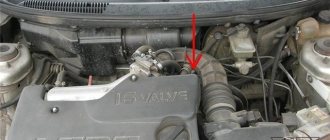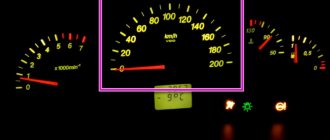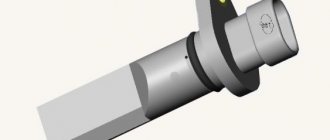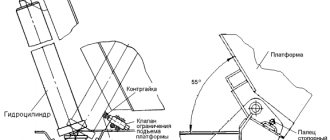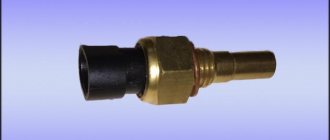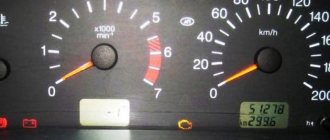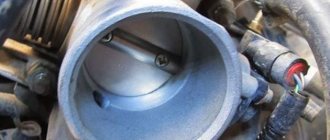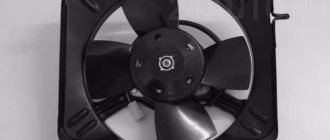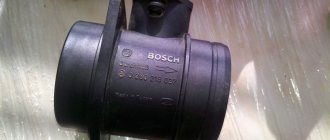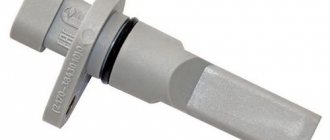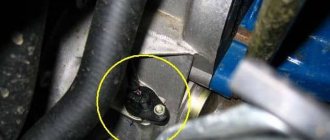The speed sensor is an element of the vehicle's electronic control system.
It depends on its readings how much fuel will be supplied, how much air will bypass the throttle valve when idling, and what the speedometer readings will be. The speed sensor of a VAZ car is based on the use of the Hall effect, that is, a stream of pulses is transmitted from the device to the car's ECU, the frequency of which is proportional to the speed of the car. Auto electronics, analyzing incoming data, selects the required idle speed and sends a signal to a device that regulates the engine idle speed, which optimizes the composition of the air-droplet mixture entering the combustion chamber, bypassing the throttle valve.
During a distance of one kilometer, the speed sensor transmits over 6000 pulses to the ECU. Based on the parameters of the time analysis of inter-pulse signals, the on-board computer transmits data to the dashboard, thereby determining the speedometer readings.
As in many other cars, the VAZ speed sensor is located in the upper part of the gearbox housing, not far from the engine oil level dipstick. You can get to it from two sides: from above, by opening the hood and disconnecting the adsorber, and from below, using the inspection hole for convenience.
Symptoms of a problem
The problem may be that the connection diagram is broken, there are disturbances in the electrical circuit, or the connector does not work. In addition, the pinout of the speed sensor, which was mixed up during the assembly process, often becomes a problem.
An indirect sign of a malfunction is that the car stalls when idling.
You, as a driver, will easily notice the presence of incorrect indicators on the speedometer, and also pay attention to the warning light that requires you to check the engine (Check Engine). If such phenomena are detected, there is no doubt - the speed sensor needs to be replaced.
How to find out if our device is faulty
We may not always notice problems right away. This can turn into a huge problem - from a fine for speeding to road accidents and accidents.
Let's look at the main symptoms of a malfunction:
- It seems to you that the speedometer does not display the speed of your car correctly.
- Faulty idle.
- Lately you have been experiencing increased gas mileage.
- You can hear from the sound of the engine that it is not working at full power.
If we consider the complaints of car owners, then most often problems arise precisely with stopping the engine when the car is coasting, or during gear changes when the clutch is depressed.
Troubleshooting
To begin troubleshooting the problem, you first need to find the device. From the photo you can determine how the speed sensor on the VAZ 2110 looks externally.
Ears for fastening
As for its location, look in the engine compartment in close proximity to the exhaust manifold. They say frankly that the place where it is installed cannot be called ideal. It's all about the collector. While the car is running, the manifold heats up. The sensor wires rub against it, which over time leads to malfunctions and short circuits.
Therefore, experts recommend that the first step is to properly insulate the wiring, and also use some kind of clamps so that the wires do not come into contact with the collector. This significantly extends its service life.
Having checked the device visually and not determining the presence of breakdowns, this tells us that the element itself is faulty. This problem can be solved by replacing it.
Some recommendations
- The search for the cause of the speedometer's inoperability should begin with an external inspection of the DS and the wires going to it. Wires often break in close proximity to the plug.
- If the speed sensor is covered with a layer of dirt or oily, you need to remove it, wipe it, reinstall it and check the speedometer readings again. Perhaps after this the instrument needle will again begin to show speed normally.
- If you cannot figure out the problem yourself, you should contact an electrician at a car service center.
Speed sensor
Carburetor models use a cable mechanical speedometer system, so there is no speed sensor. It's simply not needed.
Preparatory activities
Proper replacement of the speed sensor on a VAZ 2110 implies the mandatory purchase of a new device that meets all the requirements of your car.
Connector
Basically, when purchasing a device, follow two basic rules.
- Choose a sensor whose connectors inside the block are marked -, A and +. Usually the designations 1, 2 and 3 are used there. There is no fundamental difference between them, it will simply be much easier to carry out the pinout with such markings. It is the incorrect connection that often becomes the reason that you have to seek help from a service station. And these are completely different financial costs.
- The rod on the element must be made of metal. If the stem is plastic, it will last you about 6 months. It is not in your best interest to replace regularly. But don’t forget to check the metal rod for play, correct rotation, and the presence of a washer in the package.
Replacement
Now to the question of how to make replacements. To do this, we dismantle the old device and connect a new one in its place. Your steps look like this step by step:
- Remove the negative cable from the battery, which will allow you to turn off the power to the car;
- Now disconnect the wires from the sensor and be sure to remember what form the pinout was in;
- The device can be dismantled by simply twisting it by hand. There is usually no need to use any tools. But if the device fits tightly, then use 22 or 21 millimeter keys. Depending on the modification of your “ten”, the design of the sensor may differ slightly;
- At the same time, we recommend checking the wiring;
- After removing the meter, unscrew the fixing nut that holds the wire going to the gearbox;
- Remove carefully so as not to drop the rod into the box. If this happens, you will have to completely disassemble the gearbox. This is clearly not in your best interest;
- A new device with a rubber ring must be lubricated with transmission fluid so that the fixation in the new place is as reliable as possible;
- Assembly is performed in reverse order;
- Pay special attention to the pinout. Connect the multimeter with the ignition on. If the device showed “minus”, then you connected the wire to positive, which is absolutely not allowed. This is why we initially advised using a sensor that is not labeled 1, 2, or 3.
Installation process
The whole process can be divided into several stages:
- inspecting the car to determine whether it is necessary to replace the speed sensor and speedometer;
- selection and replacement (if necessary) of the speed sensor and speedometer;
- connecting the tachograph wires to the speed sensor and speedometer;
- examination;
- calibration and activation of the CIPF unit (performed in a specialized center).
Now about each point in more detail.
Speed sensor and speedometer
When inspecting the vehicle, you need to pay attention to the speed sensor and speedometer. If the speedometer is mechanical with a cable, then it definitely needs to be replaced, and you will also need to install a speed sensor. It is possible to use a pass-through sensor to keep the old speedometer, but this option is only a last resort. When installing a tachograph on a Kamaz , you may encounter speed sensors in the form of a small generator, which, depending on the speed, changes the voltage that is supplied to the speedometer, in which a motor is installed, the rotation speed of which directly depends on the voltage. When installing a MAZ tachograph, we may need an adapter for installing a new speed sensor; it can be picked up in a store or machined (for special extreme sports enthusiasts).
Now we connect the device to the on-board network
The tachograph connection diagram is usually different, this is caused by the huge number of not only car brands, but also their modifications. As a rule, the main wires to be connected during installation are: - power supply +12\24 Volts. It is taken from 1 power circuit or pulled from the battery; - weight. It is connected to the housing or pulled from the terminal block with ground. if there is no mass on the body/body of the vehicle (for example, MAN cars); — ignition. As a rule, it is located on the ignition switch (toggle switch) or under the dashboard, designated as ACC; — turning on the headlights/low beam. Designed to automatically adjust the brightness of the tachograph display, taken from the fuse box in which the fuse is from the light or from the wire to the headlights under the dashboard; — power supply for the speed sensor. Power goes from the tachograph to the sensor. Everything is simple here, according to the diagram on the sensor we apply a plus; — weight of the speed sensor is the same; — signal from the speed sensor. We simply connect from the sensor directly to the connector; — output to the speedometer. Connected for the speedometer to work. The connection is made from the tachograph, and not from the speed sensor. Twists “all in a bunch” are not allowed! — additional equipment as necessary (fuel level sensors, temperature sensors and additional equipment).
Purpose and principle of operation of the speed sensor
The functionality of a device such as the VAZ 2110 speed sensor is based on the use of the so-called. Hall effect, i.e. a stream of pulses is transmitted from the device to the vehicle's ECU, the frequency of which is in direct proportion to the speed of the vehicle. The electronic center of the car, analyzing the incoming data, selects the required idle speed and sends a signal to the device that regulates the engine idle speed, which optimizes the composition of the air-droplet mixture entering the combustion chamber, bypassing the vehicle throttle valve.
During a distance of one kilometer, the speed sensor, a photo of which can be seen on our portal, transmits over 6 thousand pulses to the ECU. Based on the parameters of the time analysis of interpulse signals, the on-board computer transmits the data to the dashboard, thereby determining the speedometer readings.
There is another useful function of the VAZ 2110 speed sensor, the diagram of which is presented on our resource. This is fuel efficiency. The device signals to the controller that the car is moving at a speed of 100 km/h. The throttle valve sensor transmits a signal to the controller when the driver stops pressing the accelerator pedal. The controller receives an impulse indicating the braking mode of the power plant and turns off the fuel system.
How to check the speed sensor for functionality
Symptoms of defects in this device are as follows:
- suspension of engine operation during translational movement in idle mode and incorrect speedometer values being presented at the same time;
- When defects are detected in the electrical circuit of the speed sensor, the price of which is quite reasonable, the light banner “CHECK” is displayed with parallel recording of the error code “24” in RAM.
Important: such a recording is possible even if there are defects in the operation of the mass air flow sensor, but since the “CHECK” banner in this version is not constantly displayed, it is possible that this difference will indirectly indicate which device failed in operation.
Causes of malfunction of the speed sensor
The absence of speedometer readings does not mean failure of the device. Although, to buy a speed sensor for a “ten”, it is enough to spend a small amount, but it will be very disappointing that the fact of replacing the speed sensor will not give the desired effect. And the reasons may be the following:
- The presence of dirt, dust and oil smudges on the speed sensor, a video on replacing which can be found on the Internet. They form on the body of the product during vehicle operation. To prevent the product in this case, you just need to clean the device.
- Unstable contact of the product connector and broken wiring.
- Sometimes the defect is of a purely mechanical nature, which consists of banal defects in the cable of the instrument speed indicator - speedometer.
The following options are possible here:
1. Complicated uneven movement of a braided cable, which is caused by cable defects - burrs or ruptures of the metal strands of the cable. They can significantly affect the functionality of the sensor drive. 2. Increased cable speed.
Do I need to change
Not only the speedometer and odometer readings, but also the quality of the fuel mixture supplied to the cylinders, the idle speed of the vehicle, engine stability and fuel consumption depend on the information received by the ECU from the sensor.
A failed DS will “confuse” the electronic unit, which simply will not understand whether the car is moving or standing still. As a result, the speed will begin to fluctuate, the engine will stall at idle, and fuel consumption will increase.
Checking a mechanically driven speed sensor is not difficult. On the removed sensor, we find the pin and turn it with pliers, having attached the connector to it in advance. If the speed sensor is working, the arrow on the instrument cluster will jump, if there is no reaction, then there is a problem with the drive or electrical wiring.
Checking the wiring to the instrument cluster is also not difficult, take a paperclip (you can use any other metal object) and insert it into the middle pin on the connector, then touch it to the engine housing, the arrow on the combination should twitch, otherwise you need to look for the cause in a wiring fault or sensor connector (oxidation, breakage, etc.).
Speed sensor pinout
If you understand how to connect a speed sensor, you should know that these devices differ in the degree of connection. There is the following pinout of the VAZ 2110 speed sensor, which should be followed. In this case, it is very important to study the circuit diagram of the speed sensor, which is attached to this article.
The factory speed sensor of VAZ 2110 cars is manufactured with some differences in connections to the shoe connector. The square-shaped connector is used in Bosh electronics systems. The circle-shaped connector is used in electronic systems such as January 4 and GM.
When connecting a speed sensor, you should choose devices with contact group digitization such as “-”, “A”, “+” (internal designation on the block contacts) instead of digital designations such as “1”, “2”, “3”. In addition, preference should be given to devices with a metal-type rod, since plastic rods are very short-lived.
Having decided to buy a speed sensor for a VAZ 2110, you should check the rod of the device with rotational movements and its backlash, which should be kept to a minimum, as well as the presence of such a part as a spacer washer on the rod of the product.
Speed identifier in vehicle design
Repairing any kind or replacing a speed sensor is a simple procedure, but it requires a clear understanding of its structure in the car’s design. Without knowing such information, answer questions like:
- How to check the speed sensor for proper operation?
- Where is the speed sensor located?
- How to remove the speed sensor?
- What is the connection diagram for the speed sensor?
- How to replace the speed sensor?
and many others will be impossible.
To begin with, let us repeat that the location of the speed sensor on almost all cars involves its installation in the speedometer drive (often called the sensor drive). Often, to find the speed ID, it is enough to find the wire coming from one of the front wheels and follow it to the place where it is next connected. The device he approached is a speed sensor, which is often located at the gearbox. The part almost always looks similar to the images below:
Having answered the question about where the identifier is located, you can already think about what the pinout of the speed sensor is. The typical option involves the use of wires going to:
- the sensor itself is from the speedometer drive;
- directly to the speedometer;
- main relay;
- "ground";
- controller;
- in some cases - other machine components.
Often the contact diagram of the speed sensor corresponds to the following picture:
As you can see, there are no particular difficulties in terms of location and connection of the device. Read more about how to check and remove the speed sensor below.
Replacing the "tens" speed sensor
An operation such as replacing a VAZ 2110 speed sensor is carried out according to the following plan:
- We determine the location of the device, which is located in the space between the speedometer drive and the shaft of this device, representing a flexible wire.
- With the ignition system turned off, or with the battery de-energized, remove the contact connector, bringing the spring clamps into a compressed state.
- We dismantle the spring clamps, for which we remove the fasteners using a “22” wrench and disconnect the contacts.
- We combine the speed sensor drive with the rod of the new device.
- We install the fasteners and connect them to the header connector.
If you have problems dismantling a broken rod, we buy a new part; you should choose a spare part with the same number of teeth on the gear. When installing the product, it is necessary to lubricate the rubber sealing ring with machine lubricant.
Important: when removing a faulty product, there is a possibility of a defect in the instrument rod; it is better to dismantle the speedometer drive. To do this, remove the drive using a “10” wrench and carefully remove it from the manual transmission body. Carry out dismantling carefully, do not accidentally let the rod slide into the gearbox housing.
How to check the speed sensor, what types they are and where they are located on VAZ 2110 (2111, 2112 or 2115) cars.
Why the speedometer does not work on the VAZ 2110 injector
All instruments on the VAZ 10 that indicate the speed of the vehicle are pointers, and signs of a malfunction are determined by deviations from the norm of the speedometer needle. If the speedometer is faulty, the arrow when the car is moving:
- does not deviate from zero, that is, does not show speed at all;
- stuck in one position, does not move in any direction;
- jumps, sharply changing readings, while the displayed speed does not correspond to reality.
There are other signs of a faulty speedometer, for example, the device works on a cold engine, and its readings correspond to the norm. As the engine warms up completely, the needle freezes and stops moving.
The main reason why the speedometer on a VAZ-2110 injector does not work is contamination (oiling) of the speed sensor (DS), failure especially often occurs if oil from the gearbox or engine gets onto the DS (for example, there is a leak from the valve cover of the internal combustion engine ). There are also other reasons:
- the speedometer itself has failed;
- the speed sensor is broken (this part on AvtoVAZ cars is not highly reliable);
- there is no normal contact in the DS plug or a break (short circuit) of the wires has occurred;
- The speedometer drive gears installed in the gearbox broke.
Checking the performance of the speedometer 2110
Before you start changing anything, you need to find out why the device does not show speed. First of all, they start checking with the speed sensor, since most often all malfunctions are associated with it. We inspect the DC for contamination, see if there is a break in the wires.
If the electrical part of the sensor is faulty, the Check Engine light on the instrument panel lights up. During computer diagnostics, if the sensor is faulty, the scanner displays error code P-0501, P-0501 or P-0503. Another error is detected by the on-board computer installed on the car.
There are also other signs of a faulty DS:
- at idle, the internal combustion engine is unstable, and the engine may stall at low speeds;
- fuel consumption has increased.
It is quite difficult to check the electrical circuit from the DS to the speedometer on a VAZ-2110 injector car, so here it is better to seek the help of specialists.
The DS drive gears located in the gearbox may also break. The drive itself is easy to check - you need to unscrew the two bolts that secure it with a 10th key and perform a visual inspection of this mechanism.
Types of speed sensors, their differences. Where is the speed sensor located?
Electronic 6-pulse sensors are equipped with cars with injection engines, launched into series since 2006.
On carburetor Samaras you can sometimes find 10-pulse EMF.
- Until 2006, VAZ cars used mechanical devices in the form of special inserts between the speed indicator cables and the gearbox gear outputs.
- On the VAZ-2110 (2111, 2112), speed sensors are mounted on the gearbox housings slightly to the right along the route, directly next to the oil control dipstick.
- The device is easy to find by looking in the area of the right CV joint.
- On the VAZ-2115, the electronic device is mounted on top of the front part of the gearbox (along the way) directly above the differential. The product with the connected cable is secured with one bolt on the box body.
The key difference between different types of EMF is the absence of wires and connecting connectors. For example, GM or Yantar systems are equipped with products with round (oval) ports. At the same time, Bosh uses wireless versions with square connectors.
Speed sensor malfunctions
Typical symptoms of failure of the electronic speed sensor may be:
- lack of electrical signals - error code P0500;
- intermittent electrical signals with EMF - error code P0503;
- the arrow moves chaotically in different directions, incorrect readings or other types of incorrect operation of the speed indicator;
- unstable operation of the engine at idle: interruptions, floating speed, etc.;
- increased consumption;
- power failures, when you press the pedal the engine does not “pick up” speed, etc.
There can also be several reasons for problems with the Electronic Speed Sensor, for example:
- power supply circuit break,
- oxidation of contacts,
- breakage of connecting wires or wear of the mechanical drive of the sensor.
What is it for?
The speed sensor has a lot of work to do. It informs the electronic control unit about the correct fuel supply, determines and sets the ignition timing, and is responsible for the quality of the air-fuel mixture.
Scheme
The sensor collects all kinds of data and transmits them in the form of signals to the electronic control unit. There, the information is checked and appropriate adjustments are made to the operation of the injection engine.
How to check the speed sensor
Most often, the failure of the EMF is a consequence of a break in the electrical circuit. Therefore, it is first advisable to check the integrity of the wiring and the condition of the connectors (contacts).
It is easy to check the functionality of the electronic sensor with your own hands if you have a multimeter. To do this, you must first dismantle the product. Then determine the contact through which electrical impulses are transmitted.
It is usually located in the middle of the block.
- Connect it to the positive lead of the measuring instrument.
- Having closed the negative cable to the machine body, rotate the EMF rod within a speed of 5 mph.
- Check the multimeter readings.
- As the rotation intensity increases, the device readings (frequency and voltage) should increase proportionally.
Functionality check
There are several options for diagnosing DS.
The first way to check is with a multimeter:
- First you need to dismantle the DS.
- Then, using a tester, you should determine what each contact on the connector is responsible for; you need to find exactly the pulse one.
- After this, the positive probe of the tester must be connected to this contact, and the negative probe to the power unit or car body.
- Next, you should install a piece of tube on the controller axis and start rotating it at low speed. At the same time, monitor the controller readings - the higher the rotation speed of the DS tube, the higher the values on the tester display and the voltage parameter will be (the author of the video is the REMONTYCA channel).
Second method, without removing the controller:
- Using a jack, you will need to lift the front wheel of the car. Which one - right or left - does not matter.
- Then the tester should be connected to the DC wiring.
- After this, you begin to rotate the car wheel with your hands and monitor the readings on the tester display. If there are impulses, then this indicates that the DS is operating in normal mode.
